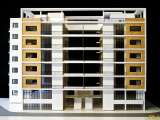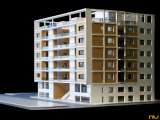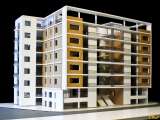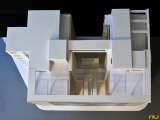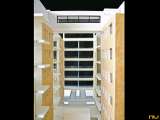|
Giuseppe Terragni and Pietro Lingeri constructed this apartment building over a trapezoidal plot bounded by three streets; one of them Corso Sempione, one of the major thoroughfares in Milan’s urban development from the 1920s and the site of other examples of rationalist architecture. Of the five collective housing buildings designed by the architect in Milan, only Rustici House manages to overcome his usual linguistic obsession – almost a consoling refuge in a clearly speculative programme – to grapple with the problem of the corner and the facade in the modern city. Terragni proposed adding two parallel bodies perpendicular to the main street to the usual scheme of a tall body and two lower ones on either side of it. Through a system of walkway-balconies which joins the two facades facing Corso Sempione, he creates a symmetrical yet tense and fragile facade like a torn diaphragm whose interior virtually encloses the large inner courtyard between both bodies. The treatment of the other two facades – the ones facing the side streets – stresses the expression of the structural framework which at the penthouse level is contained by flat, continuous eaves running along the entire facade. On the north, Terragni added a secondary body, set back and distinguished by the opening of the courtyards along its entire vertical plane.
The main entrance is placed at an axle off Corso Sempione through staircases that lead to an area housing the vertical circulation nuclei for both blocks. The resulting basement contains the service quarters and a car park accessible via two ramps. The five standard floors that make up the bulk of the building all share the same layout – with the exception of the spaces in the block on the northern side – and are divided into two units per floor. The top storey, originally reserved for the owner of the building, was built as an independent unit, like a villa set apart from all the facades and surrounded by terraces and gardens. The communal area is placed atop the northern body, while the bedroom zone is above the southern block, both of them connected by a bridge that crosses the courtyard at a height of 25 metres.
Terragni uses white marble to graphically reinforce the display of pillars and columns, as well as other elements like the lateral body on the northern side, while the rest of the surface is clad in ochre-coloured plaster. The entrance landing is covered with a canopy made of concrete and glass bricks, similar to the solutions used in Casa de Fascio in Como, Italy. Despite the insistent expression of the structural syntax on the facade and the dynamism introduced by the more floating, lighter elements that intervene in the composition of this building, the structure on the floors seems confused with the partition walls within relatively conventional layouts.
Fernando Alvarez Prozorovich
|

